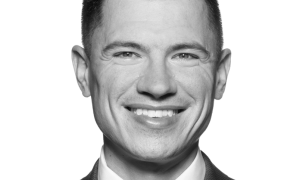It’s a little after 12:30 p.m. at the Port of New Orleans. Gov. Bobby Jindal has assembled a room full of local parish leaders and high-ranking state officials to unveil a four-point plan for revitalizing the Louisiana coast in the aftermath of the oil spill. It’s bold, transformative, even inspirational. In the absence of federal leadership, Jindal is forging ahead, taking control of a desperate situation.
Jindal is full of energy and enthusiasm as he commands the meeting. He works through his four items, then delves back in for a second go-around to explain them in more detail. Earlier that day he put the finishing touches on his plan at the governor’s mansion, received a briefing at the state homeland security headquarters in Baton Rouge and headed to New Orleans to outline his agenda. A half-dozen TV cameramen wait outside in anticipation.
There’s a crisis in Louisiana. Even with the leaking well capped, the cleanup has just begun. It could be years before fishermen return to their livelihoods. Perhaps decades before the oil is completely gone from the marshes, estuaries and wetlands.
Jindal, elected in 2007 after representing the 1st District in Congress, was viewed as a national leader long before the oil spill. He was a wunderkind who ran the Department of Health and Hospitals at the age of 25. His knowledge of policy — and success implementing it in Louisiana — as well as his political acumen have prompted speculation about a future presidential run.
But that’s a long time away. Right now he has other things on his mind. When the oil started spewing from the Gulf of Mexico three months ago, Jindal set his team in motion. The state’s emergency response website serves as the go-to source for information on the spill. Since April 22, it’s had more than 300 updates on everything from recreational fishing to requests for federal help.
Information overload? Not for Jindal. He’s constantly consuming data. This is evident at the daily briefing he attends on the oil spill. He asks pointed questions about the status of the cleanup, pushing for more details about oil sightings and skimmers.
While there’s widespread condemnation of the federal response — either President Obama’s procrastination or the Army Corps of Engineers’ red tape — Jindal enjoys widespread support.
During a town-hall meeting in Lafitte, La., the mere mention of his name drew hearty applause from the standing-room-only crowd. And it wasn’t some Republican cheerleader singing his praises. It was Ken Feinberg, the man tasked by Obama to administer BP’s $20 billion claims fund. Jindal wasn’t at the meeting, but when Feinberg acknowledged the governor and thanked him for the invitation, the crowd burst into applause.
Jindal’s four-point plan won’t be easy to implement or execute. He wants to put in place an ambitious coastal restoration project to restore the ecosystem, get fishermen back on the water quickly, lift the federal government’s offshore drilling moratorium and hold BP accountable for damages to the environment.
As challenging as it might seem, it’s at least a place to start. His vision offers hope to a state battered by bad news. Ever since Hurricane Katrina in 2005, it’s been an uphill battle. Hurricanes Rita, Gustav and Ike took their toll, the recession slowed economic progress, and just last week Northrop Grumman announced it was pulling out of the Avondale shipyard, taking 5,000 jobs with it. It’s downright depressing after factoring in Obama’s cancellation of NASA’s Constellation program, costing 2,700 jobs at the Michoud Assembly Facility, and the six-month drilling moratorium, impacting upwards of 22,000 jobs directly or indirectly.
Through it all, Jindal has remained upbeat and optimistic. He’s crisscrossed the state in the aftermath of the oil spill, winning the allegiance of parish presidents and local mayors. They stood by his side as he unveiled his plan to revitalize coastal Louisiana. More importantly, they echo his agenda during live TV shots or at public events in their communities.
Jindal knows the remainder of his term won’t be a cakewalk. Unlike Hurricane Katrina, which captivated the nation for months and years, the cleanup probably won’t generate the same level of attention or sympathy with the oil no longer flowing. “Is It Over?” read USA Today’s lead headline Friday, suggesting it was time to move on from a story that has come to bore the press.
That’s not lost on Jindal. His response to last week’s good news: It’s too early to declare victory. “We have been fighting a war against this oil for months now and we know our battles don’t end even when the well is capped,” he said.
Then, doing what he does best, he shifted from straightforward chief executive to awe-inspiring leader with a compassionate heart and optimistic outlook.
“I have no doubt that we will come back stronger than ever before from this disaster, just as we have done in our recovery from four devastating storms in three years,” Jindal said. “It’s the perseverance of the people of Louisiana that will ensure our successful recovery and fully restore our Louisiana Way of Life.”
If Jindal has no doubt Louisiana will persevere, it would be foolish to doubt him.
Robert Bluey directs the Center for Media and Public Policy at The Heritage Foundation.
First appeared in The New Ledger

